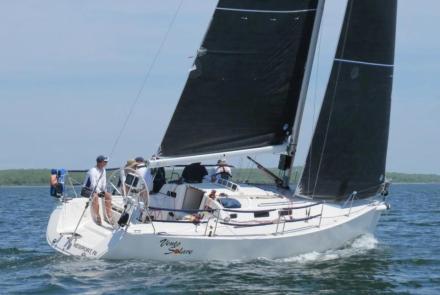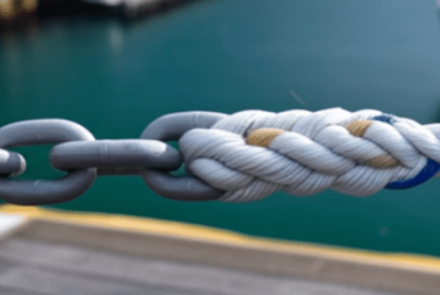Carleton Mitchell
By John Rousmaniere, A Berth to Bermuda © John Rousmaniere
The 38-foot yawl Finisterre was finishing high up in almost every race she sailed in the 1950s. But what she is remembered for is her Bermuda Race performance: three races, three overall victories. In the vast firmament of sailing records, the polestar is this tubby little yawl commanded by this gifted sailor, writer, and photographer. It is hard enough to win one Bermuda Race, but two in a row? Dick Nye of Carina had an explanation: “For one thing, she’s got everything. And he sails the hell out of her.”
You need a good boat, a skilled crew, and a perfect organization. Above all, you must push very, very hard. Mitchell liked to quote a Bahamian saying about the weather, “You eats what the cook serves.” In other words, you do your best in the conditions at hand. “My theory was that the time to get everything right is before you leave the dock,” he once said. “And then, once you leave the dock, to be able to drive the hell out of the boat and never have to worry about something carrying away. And if anything did let go on you, the spares were on board with the know-how to put it back together.”
With her 11’3” beam on a waterline of just 27’6” – a bulbous shape in the 1950s -- “the fat little monster,” as Mitchell sometimes called her -- Finisterre had immense room as well as the initial stability and inertia needed to carry sail in conditions when other boats are reefed down. In her first race, as she was beating into a hard blow in the company of 50-footers, one of Mitchell’s crew, an amiable Bahamian named Bobby Symonette, mused, “I wonder how the little boats are doing tonight.” He had forgotten that he was in the smallest boat in the fleet. With such heft, sailing in a calm is a problem, but as Olin Stephens has admiringly commented, “her skipper and her crew maintained an almost magical degree of concentration to keep her moving in light airs.” His crew of eight included some of the best racing sailors of that time, looked after by a full-time cook (Mitch, as he was known, had faith in creature comforts).
Long before Loran and GPS made navigation routine, Mitchell also insisted on carrying at least two skilled celestial navigators besides himself so a sight could always be taken when the overcast cleared momentarily. Once, Finisterre got lost near Bermuda and the third navigator stepped in. “We didn't know where the hell we were,” Mitch told me recently. “Then with Bunny Rigg holding me, I took a moon sight and we came out right at Northeast Breaker. It was an easy sight.” It may have been easy for him, but tell an experienced navigator that an owner near the reefs bet the farm on one of the trickiest sights there is, with the moon racing across the sky so fast that an error of a fraction of degree or second can be fatal, and the response is a stunned, respectful silence.
There is more to Carleton Mitchell than his life as a great racing skipper. For every mile Finisterre raced, he estimates that she cruised at least 10, making good on the promise of her name that she could thrive in that place where (as Thomas Fleming Day called it) people could “get a smell of the sea and forget for the time being that there is such a thing as God’s green earth in the universe.” Mitchell’s writing on this subject was no less luminous. This is the man who wrote, “To desire nothing beyond what you have is surely happiness. Aboard a boat, it is frequently possible to achieve just that: That is why sailing is a way of life, one of the finest of lives.” After winning the 1956 Bermuda Race, she cruised to the Med and back. After winning in 1958, she did no racing at all until 1960, when she won again. Soon she retired from racing so her owner could cruise full-time. After selling Finisterre, he took another bold step and in 1968 bought one of the first smaller trawler yachts. As he cruised in this floating home (called Sans Terre), he wrote articles that brought this new approach to boating to the public’s attention.
A prophet, a racer, and a cruiser, Mitch also was one of our best boating writers and photographers, with seven books and hundreds of articles to his credit. As a young sailor who read everything, I so identified the name “Carleton Mitchell” with writing and photography that when I heard that someone also named “Carleton Mitchell” won the 1956 Bermuda Race, I asked my father if the two men were related. When he explained that they were one and the same, I thought to myself, “Well, gee – I guess this fellow can sail pretty well, too!”
Mitch began pursuing boats and words soon after taking his first youthful sail in an uncle’s racing sloop off New Orleans. He kept a scrapbook in which he pasted pictures of boats and wrote captions, and when he was 12 he answered an inquiry about his plans for a career by announcing, “I want to sail and write about it.” That dream survived college in Ohio and mundane jobs in the Depression (for a while, he sold women’s underwear at Macy’s in Manhattan). It even survived a wretched experience in a leaky old ketch that almost sank in the Gulf Stream. When the ketch staggering into the Bahamas, he began his lifelong love affair with the Islands.
He found jobs as a photographer in Nassau and in the wartime navy’s photography department. After the war, he bought one of John Alden’s old Malabars, renamed her Carib, and sailed south to the West Indies. His book Islands to Windward introduced the Caribbean’s charms to sailing Americans long before the first bareboat fleets arrived. Moving to a 58-foot Rhodes centerboard yawl he named Caribbee, he won a race to England and wrote a wonderful book. Illustrated with some of his best photographs, Passage East is the story of a challenging voyage with meditations on the fascinating, elusive relationship between the sea and sailors. One of the best reveries in sailing literature is Mitch’s ruminations about “the somewhat fantastic nature of ocean racing”:
“Here we are, nine men, driving a fragile complex of wood, metal, and cloth through driving rain and building sea, a thousand miles from the nearest harbor; no one to see or admire or applaud; no one to help if our temerity ends in disaster. . . . Our attitude is not even wholly based on the competitive aspect of racing. It is that we all feel there is just one way to do things, one standard, one code, and we live up to it for our own satisfaction. We are driven by our own compulsions, each personal and secret, so nebulous we probably could not express them to our mates if we tried. But in our own way, we are about as dedicated as it is possible for men to be.”
Woman or man, cruiser or racer, who can find fault with that?
Carleton Mitchell was 42 when he wrote that paean to adventure. He was still pursuing his watery compulsions half a century later as he cruised with his wife, Ruth, in his powerboats on the Mediterranean or from his South Florida home to his beloved islands. He celebrated his eighty-ninth birthday by sailing in Finisterre, which after years of decline in the Caribbean had found a good owner who kept her in Venice, Italy, and took her out on the Adriatic. An accident called a halt to such pleasures, but in August 2005, he told a friend who had called to wish him a happy ninety-fifth burthday, Mitch announced that he was looking for another new boat – a simple, old-fashioned, one-deck houseboat on which he could get around in his wheelchair. It was just like Carleton Mitchell to want to get back to the water in something beamy and comfortable




